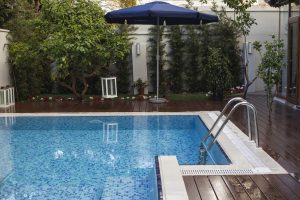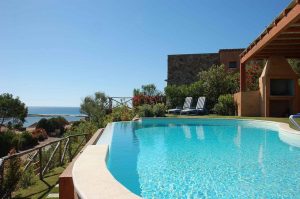
Being able to run a water pump without relying on grid electricity can range from simply saving money on electric bills, to being absolutely essential if you’re somewhere where electricity just isn’t reliable or even available at all.
Solar power can also be a fantastic replacement for a diesel generator.
In this article, we’ll look at how much solar power you’ll need to run a 1.5 HP pump (one of the most popular types) under different conditions, as well as how to work this out for pumps with different power ratings.
How Many Solar Watts Are Needed to Power a 1.5 HP Pump Without a Battery?
The short answer is you’ll need around 2 kilowatts of solar panels to be able to consistently run a 1.5 HP pump without a battery. That’s if you’re in a reasonably sunny location such as California. As well as the location where you and your 1.5 HP pump are located, as well as other factors such as the type of pump, and whether you’re grid connected.
This is because a 1.5 HP typically uses 1.1kW of electricity. Accounting for around a 10% loss from the solar panels producing electricity, due to the inverter, wiring, and other losses, then you’ll need 1.2 kW of electricity to run a 1.5 HP pump. To be able to run the pump most of the time, even on cloudy days then a 2 kW solar system should be sufficient.
However if you want to be able to run the pump before or after the sun is up, then you’ll either need to have a grid connected system or add a battery so you can run it off grid.
Remember that water can be it’s own kind of energy storage, cheaper than a battery. If your use case is pumping water out of the ground, then it’s more efficient to pump it up into a raised tank during the daytime for use after sunset, than to rely on a battery to run the pump on demand at any time.
The other issue is that without a battery or having a grid tie system, you will need to have a pump that is specifically designed for running directly from solar, such as a Grundfos pump. This is because standard pumps require a starting power that can be several times more than the power required when up to speed.
Water Pumps Designed for Use With Solar
As we’ve already touched on, there are water pumps that are specifically designed for use with solar panels.
You should get a solar water pump if:
- You want to pump water in an off grid location without grid electricity
- You don’t want a battery, and you’re okay with only running the pump during the day
You’ll benefit from a solar water pump, but it’s not essential if:
- You’re off grid but have a reasonable sized battery system
You’ll be fine with a regular pump if:
- You have a grid tie solar system
How are solar water pumps different from regular ones?
Solar water pumps are designed specifically as part of an overall solution for off grid water access.
This often means that they have a built in solar inverter to convert the DC (Direct Current) electricity that solar panels produce into AC (Alternating Current) that the pump requires. Or, they may be directly DC powered.
They are also engineered to have a low starting current. Like riding a bicycle, it requires more effort to get a pump moving from a full stop, than it does to keep it running once it’s up to speed.
Because of this, most water pumps require more power to get them going. That’s normally not an issue if you’re connected to the grid, but if you have limited power available then it could mean that you technically have enough power to keep the pump running, but it won’t actually start.
With this in mind, solar water pumps have been designed to be able to get started without such a large spike in current required. That means they can be run directly from solar panels without requiring a battery or even a separate inverter, which enables you to create a very simple, reliable, and easy to maintain off grid water supply solution.
Running a 1.5 HP Pump Off Grid
If you don’t have access to grid electricity, or you’re looking to replace an expensive, noisy generator, then a solar powered pump is an ideal solution.
One aspect to consider is whether you should add battery storage to your system. This depends on the use case for your pump.
If you need to pump groundwater up from a borehole, or well, then the most efficient and cost effective solution is most likely to add water storage rather than electrical (battery) storage.
It’s much cheaper and simpler to add a water tank than an expensive lithium battery. Although if you do decide on battery storage, you can use our off-grid battery bank calculator to work out how many batteries you need.
In this situation, you need to have a water tank that’s large enough to at the very least supply your water needs throughout the evening and in the early morning before sunrise.
However it’s prudent to add extra capacity to have some backup in case you have any issues with your water pump.
Grid-Tie Solar for a 1.5HP Pump
In some ways, grid connected solar is much simpler. Instead of having to add redundant capacity, and be very accurate with your calculations, you simply need to offset the electricity usage.
The grid will still be there as a backup, and to do any heavy lifting if your pump has a high starting current (most standard AC water pumps do).
A grid tie system needs to be professionally installed, and because of the cost of installation, it’s most efficient to build out a whole home system that includes capacity to power your water pump, rather than having a dedicated solar system for your water pump.
Running a Swimming Pool Pump with Solar Panels
This article has been primarily focused on pumping water for drinking or irrigation, but the same principles apply for running a swimming pool pump on solar panels.
Swimming pool pumps are also typically around 1.5 HP. The one where I’m currently living is actually a bit less at 1 HP.
Swimming pools are often attached to a property that does have grid electricity, so instead of having to worry about starting current and over sizing the system, you can typically just offset your overall usage of the the swimming pool pump.
Of course if you’re in an off grid location, or you simply want to have your swimming pool on a separate solar powered system, then the best solution is to run your pool pump during the day when it’s sunny.
It’s also worth replacing it with a variable speed pool pump, which typically save up to 90% on electric use when compared to a standard one. This results in a much smaller solar system being required.






